The election of Abraham Lincoln in November, 1860, incited anger across the South. Following on the threats of secession made by some Southern states before the election, the departure from the Union of South Carolina and others between December and February of 1861 broke the U.S. in two. Seeking to establish itself and gain foreign support for its independence, the new Confederate States of America organized its first diplomatic outreach.
The attack on the U.S. garrison at Fort Sumter by South Carolina forces on April 12, just a month after Lincoln’s inauguration, brought the two into military conflict. The beginning of the American Civil War represented key moments for the military and diplomatic spheres of the war. The South’s strongest military performance, being able to argue themselves military equals of the North, is found in its early stages. Moreover, the idea of a secondary, Anglo-American war was closest to being realized during this period.
The Morrill Tariff Passes
A contentious pre-war political debate, the proposed effects of the Morrill Tariff divided Republicans and Democrats alike. It sharply raised the import tariff, making it’s impact upon the costs of goods from the U.K, chiefly manufactured textile products, deeply unpopular with British industrialists, politicians and laborers. The resentment fostered by the Tariff, as well as later economic measures to support the Union war effort, were capitalized upon by Confederates in their diplomatic appeal to the British.
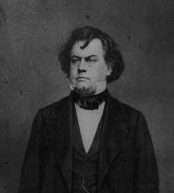
First Confederate Diplomats
The first envoys of the Confederate States are assigned to Europe. Confirmed by President Jefferson Davis and his first Secretary of State, Robert Toombs (pictured), Ambrose Mann, William Yancey and Pierre Yost to given the task of advocating for Southern recognition in Europe, though only Mann stays in his position long-term. Later envoys, such as James Mason and John Slidell, build off and expand upon the early networks and arguments made by Mann.
(Image Courtesy of the Library of Congress)
Union Blockade
Following the April 14th attack Fort Sumter by South Carolina, President Lincoln puts in motion steps towards the creation of wide ranging naval blockade of the South. Part of the Union strategy known as the Anaconda Plan – proposed by Gen. Winfield Scott – the blockade, once fully implemented, effectively cut off the Confederacy. Southern trade was limited to smuggling through blockade runners, and economic and military obstacle the South never overcame. The inability of the South to break the blockade, and their own unwillingness to contest it, further prevented the participation of foreign powers in the Civil War.
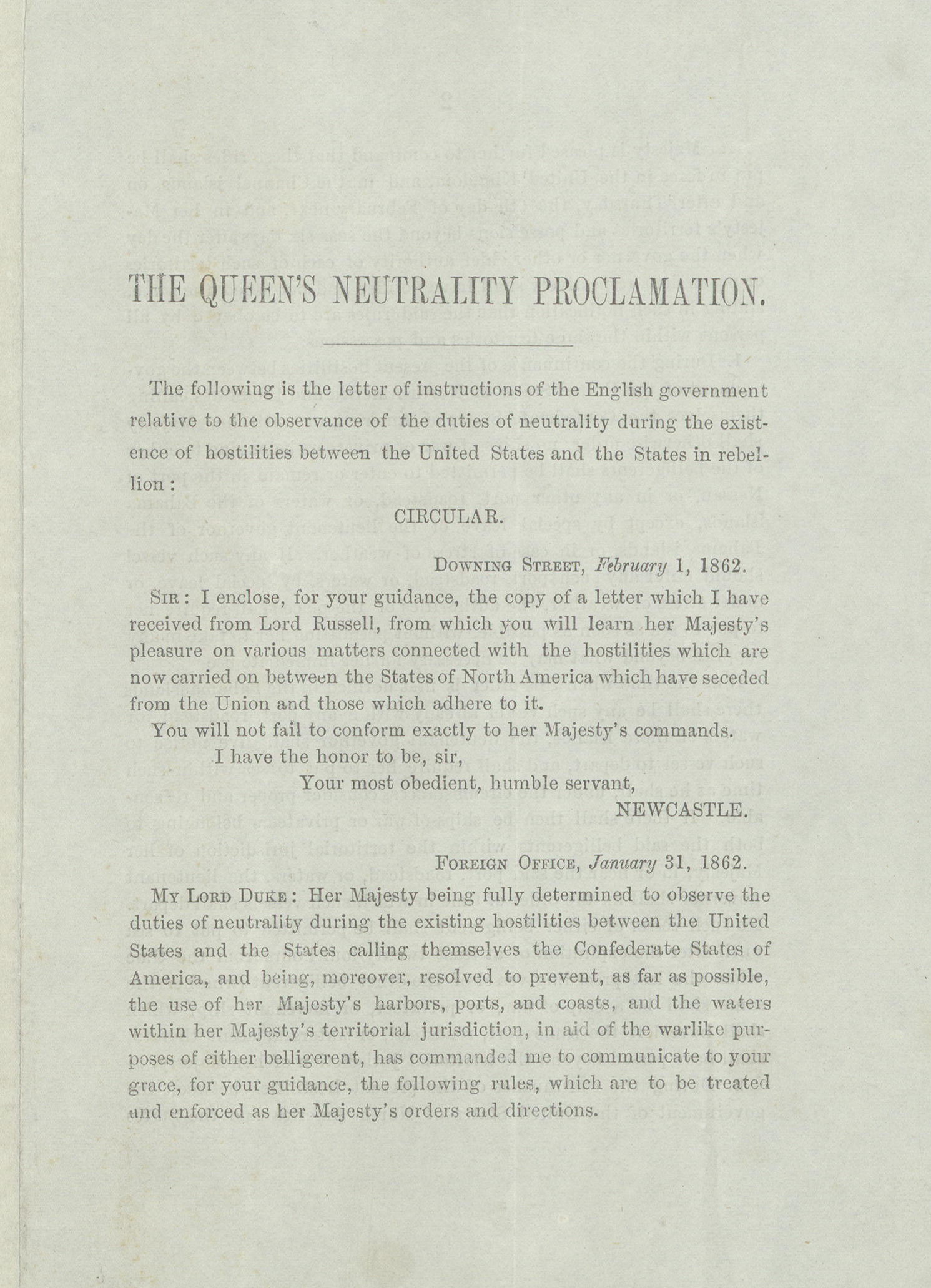
Queen Victoria’s Neutrality Proclamation
In response to events in North America, Queen Victoria issues a statement affirming British neutrality in the conflict. Of note in her statement is the conference of belligerent status to both the U.S. and the C.S.A. This equal status in the eyes of neutral powers, not true recognition, nevertheless gave hope to early Confederate efforts to attain further support for the South’s cause.
(Image courtesy of the Library of the Congress)
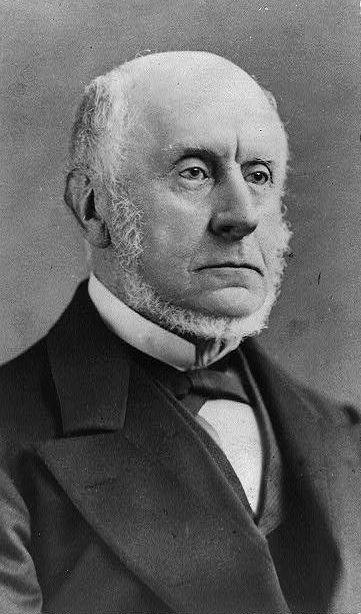
Charles Francis Adams Assigned
The son of former president John Quincy Adams, Charles Francis Adams accepts the post of American Minister in London. From his offices, Adams will monitor British interest in the conflict, as well as the actions of Confederate sympathizers. His actions play a crucial role in diplomatic dialogue and in mediating tension between the Palmerston government and the Union, and the legal observations Adams makes factor into post-war debate over British culpability.
(Image courtesy of the Library of Congress)
First Battle of Bull Run (First Manassas)
The first major engagement of the Civil War results in a Union defeat. While neither side clearly outmatches the other after the battle, Northern forces flee the field. This retreat, witnessed by residents from Washington D.C., was covered for the Times of London by their famed war reporter William Howard Russell. Russell’s own descriptions of the battle further embarrassed the Union in Britain, factoring into early foreign perception of the South’s military ability.
The Trent Affair
Opening up a controversy that nearly brought the U.S. and Britain into a war with one another, two Confederate diplomats – James Mason and John Slidell – are arrested aboard a British mail carrier, the RMS Trent. A perceived violation of British neutrality, angry public responses in both the U.S. and Britain lead to calls for further action. Fluctuating tension over the rest of the year involves diplomatic ultimatums and the movement of British military forces to Canada. By late December, President Lincoln and Secretary of State William Seward acquiesce to British demands, and free the envoys.

The Lyons-Seward Treaty
In part resulting from Sec. Seward’s desire to avoid further escalation with Britain, negotiation with Lord Lyons, the British minister in Washington, D.C., results in an agreement towards greater Anglo-American cooperation. Building upon earlier, less direct approaches, the new treaty enhanced both American and British efforts in cracking down upon the lingering elements of the Slave Trade. Allowing for broader search powers for military vessels of both nations, it was an aggressive step towards ending the practice in the Atlantic World.
(Image courtesy of the New York Public Library)
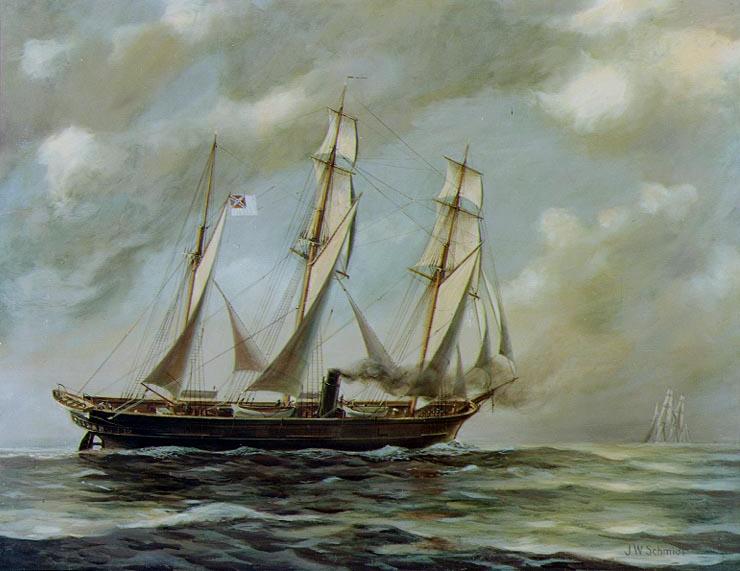
CSS Alabama Commissioned
Built in the British shipyards of Birkenhead outside Liverpool, the Confederate commerce raider Alabama begins her career off the Azores’ Terceira Island. Inflicting millions in damages to Union shipping over a two year career, news of her actions and origins raised fury in the North. Years after 1864 sinking, the matter of recompense from the British was still a subject of debate, with a final series of negotiations concluding the issue in favor of the U.S. in 1872.
(Image courtesy of the US Navy Center)
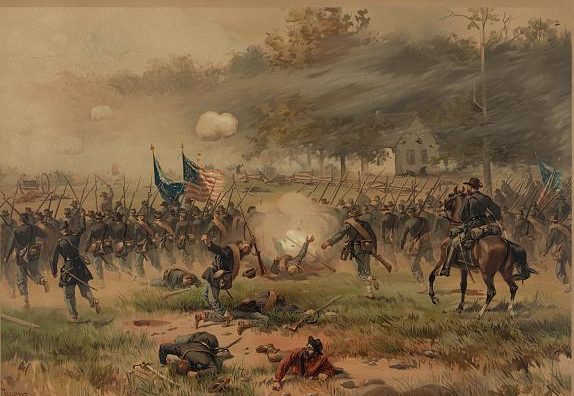
The Battle of Antietam (Sharpsburg)
The bloodiest day of the Civil War, the Battle of Antietam -while militarily inconclusive by itself- turned back a Confederate advance into the North through the state of Maryland. The ending of the Maryland after Antietam gave President Lincoln an opportunity long awaited. The victory represented groundwork from which to announce his plans for an eventual emancipation of slaves, the Proclamation going into effect with the New Year.
(Image courtesy of the Library of Congress)
Manchester Workingmen Gather
Following news of Lincoln’s plan for the Emancipation Proclamation, and amid the ongoing economic pressures of cotton shortages due to the war, workingmen and reformers gather to write a letter of support to the president. In spite of their own hardships, their message lauds Lincoln’s role in bringing about change. Lincoln’s presence would inspire further action on the part of British reformers, the post-war political reforms within the U.S. factoring into the growth of labor and political movements in Britain.